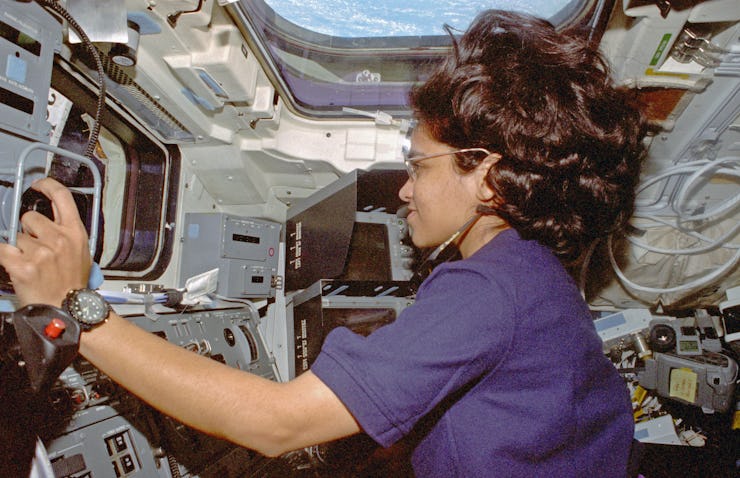New Study Suggests One Aspect of Space Travel Can Accelerate Aging
The microgravity environment could hasted age-related issues.

Space travel is not normal. Humans did not evolve to spend extended time in microgravity environments without having to use their muscles to stand upright, all while being bathed in cosmic radiation, and it shows in the health of astronauts: Extended stays on the International Space Station leave crew members with less bone and muscle mass, along with changes in metabolic and genetic markers associated with getting older.
“We don't really as humans understand aging, but we have these biomarkers that we can test,” Jeremy Sabo, a Ph.D. candidate in biochemistry and molecular biology at Oklahoma State University tells Inverse. “It turns out that microgravity pretty much increases the rate of all biomarker-measured aging-related things.”
Exactly why and how being in space causes these changes is still the subject of a lot of research, including new work out of the lab of Rita Miller, a professor of biochemistry and molecular biology at Oklahoma State University. In new work to be presented for the first time on March 28 at the annual meeting of the American Society for Biochemistry and Molecular Biology in Seattle, Sabo and Miller have uncovered how a protein known as SUMO (Small Ubiquitin-like Modifier) may change cells in response to a microgravity environment.
“Under normal gravity conditions, SUMO is known to respond to stress and to play a critical role in many cellular processes, including DNA damage repair, cytoskeleton regulation, cellular division and protein turnover,” Miller said in a statement.
In a simulated microgravity experiment with yeast cells, the researchers found SUMO binding with proteins — known as SUMOylation — increased the abundance of some proteins in cells by more than 50 percent to compared to cells in normal gravity. It’s not yet clear exactly what SUMOylation is doing and why, but it's a step in the right direction for scientists who want to understand the molecular underpinnings of space-related changes in astronaut health, and maybe one day mitigate them.
“For the most part, SUMO is always doing something good for the cell,” Sabo says. “But biology is biology, and we never really know, so it may not be.”
Microgravity can change humans at the cellular level.
SUMO, Cells, and Space
After allowing yeast cells to divide six times in normal gravity, in microgravity, and in microgravity with SUMOylation of proteins, the researchers found 37 proteins that were changed by more than 50 percent by SUMO while in microgravity. The proteins are known to be involved in structuring cells, cell division, and repairing damage from radiation.
For example the protein Stu1, which normally helps structure the microtubule structures that make up the cytoskeleton of a cell, giving the cell its structure.
“Stu1 protein abundance is decreased by 55 percent in simulated microgravity,” Sabo says. “However, when Stu1 is bound to SUMO its protein abundance is increased by 442 percent in simulated microgravity.”
To simulate microgravity, Sabo, Miller, and their colleagues used rotating wall vessels, cylindrical devices developed by NASA that use the centrifugal force of rotation to counteract the force of gravity. Because the cells experience less than the normal, unidirectional pull of gravity, “it’s a microgravity environment,” Sabo says. Though “because it's not actual space [microgravity], NASA makes a big deal about always referring to this as ‘a simulated microgravity environment.’”
The cells spent 12 hours in the rotating wall vessels, allowing them enough time to divide at least six times.
“That allowed us to ask the question, ‘how is Sumo still impacting the adaptation to microgravity?’” Sabo says. “We would think that if Sumo just showed up and then helped with the brief introduction of stress, and then the cell did its thing, it would go back to a basal level and there'd be no difference between the gravity and the simulated microgravity condition.”
Ed White takes the first American spacewalk in 1965.
Enigmatic changes
That the protein abundances remained elevated suggests that SUMO is mediating a cellular response to microgravity, according to Sabo, but it's not yet clear what that response means. When it comes to proteins like Stu1, ”We see that there's a difference in microgravity when it's SUMOylated versus when it's not SUMOylated,” he says. “But we don't know what it's doing.”
But if further studies elucidate the actual role of SUMOylation, it may present targets for medications or other interventions that could help reduce the health effects of space travel. Sabo notes that SUMO is already a target for pharmaceutical research on treating cancer, Alzheimer’s disease, and other conditions on Earth. And if boosting SUMO activity helps fight biomarkers of aging in space travelers, “that information is going to allow us to translate what we learned from keeping people alive in space back to Earth to how we can better circumvent the ailments that come with aging,” Sabo says.
The next big thing Sabo would like to tackle in his PhD work is to follow up and explore what SUMOylation of proteins like Stu1 are actually doing in microgravity. A logical follow-up, for instance, would be to conduct the same experiment with a source of radiation to see how it affects the abundance of DNA repair proteins, which were already increased by SUMOylation in simulated microgravity alone.
“We don't know if that's advantageous, or when paired with radiation, is going to be an even bigger catastrophe,” Sabo says. “So that would be another step is to repeat the experiment and just add radiation, and see if radiation is repaired faster or if it's repaired slower.”
This article was originally published on